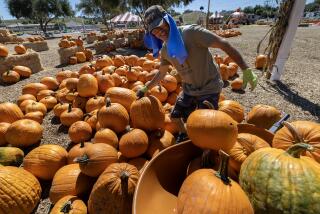The Life of Pie
- Share via
MORTON, Ill. — Mark Pfeifer loves pumpkin pie more than any sane healthy man should.
The warm autumn air is thick and sweet, and the sound of metal blades mashing pumpkins drowns out conversation as Pfeifer -- the operational manager of Libby’s processing plant -- loosens his belt for his daily dessert duty.
Pfeifer slips into the plant’s laboratory. There, among the test tubes and glass beakers, sits a line of pumpkin pies.
Warm. Welcoming.
The pumpkins used to make these pies have been grown and canned in this central Illinois town, which produces 80% to 90% of all the canned pumpkin sold in America.
Before the pumpkins hit store shelves, Pfeifer must taste-test a sample from each batch. Using the recipe printed on the back of the can, the plant’s test kitchen reproduces the baking steps taken each year by countless home cooks, and Pfeifer is here to make sure the pumpkin lives up to its part.
Blended with spices and condensed milk, the pumpkin mixture is poured into pie shells and baked. Pfeifer walks across the linoleum floor, grabs a knife and cuts a slice no wider than his thumb.
“Every day, there are pies that we have to taste. That’s every day we work, every day for 10 weeks or more,” Pfeifer said. “I’m on my feet for 13 hours a day, working in 100-degree heat, and I’m still 20 pounds overweight.”
From the first days of harvest in late August to early November, when the canning is completed, this plant processes about 150,000 tons of pumpkins -- or enough to make 90 million pies.
Lined up, crust to crust, they would span from Plymouth Rock to the Oregon coast five times, said Tim Miller, a quality assurance manager for Nestle USA, which owns Libby’s and the processing plant. That’s enough dessert to fill a road that would stretch halfway around the world.
“We have a lot of time on our hands during the off-season to figure these sorts of things out,” Miller said.
Although food historians can trace recipes for pastries filled with a mixture of stewed squash, sugar, spices and cream to medieval times, experts say the modern pumpkin pie dates to the 1700s. By then, European settlers had adapted their holiday traditions of serving meat or fruit pies and began using local crops such as pumpkins.
Over time, recipes were passed down among families and neighbors, and the pumpkin pie soon became a Thanksgiving tradition. A pie recipe has appeared on Libby’s cans of pumpkins for at least 50 years.
With Libby’s crop and other edible and ornamental squash, Illinois farmers grow one-fourth of the nation’s pumpkins. The state’s harvest is worth about $12.3 million a year, according to the U.S. Department of Agriculture.
Morton’s identity is clearly linked to pumpkins. The sign leading into town features a bright orange pumpkin. Locals sip coffee in cafes and debate whose pie recipe is the best. Nearly a dozen shops specialize in pumpkin merchandise: ornaments for Christmas trees; candy for Easter baskets; and flags for the Fourth of July.
It wasn’t always like this.
Back in the 1800s, when the town was just forming, the land was boggy and thick with hardwood forests. Immigrants came here eager to work in the logging industry. Many families nurtured small vegetable gardens, and a few farmers struggled to plant crops in their marshy fields.
The forests thinned over the decades, and the watery land was drained. What emerged, by the early 1900s, were miles of soil, black as ink with an abundance of nutrients.
“Farmers replaced the loggers, and the crops grew,” said Mike Badgerow, executive director of the Morton Chamber of Commerce.
In 1929, Libby’s bought the canning plant near the center of town. The plant then canned corn and peas.
The company also acquired all rights to the Dickinson pumpkin, brought to the region by Kentucky farmers in the 1800s and preferred by locals for their holiday pies. After signing contracts with local farmers to grow the squash, Libby’s began canning pumpkins here along with the other vegetables. For decades, though, most of the company’s pumpkin was processed in nearby Eureka.
In 1973, Libby’s started processing its entire pumpkin crop at the Morton plant because it was closest to the pumpkin fields.
Libby’s main rival, Seneca Foods Corp., has a smaller packing plant about 30 miles east in Princeville. And like Libby’s, Seneca and other independent companies have spent years modifying and altering pumpkins to produce their own special strain to can.
On the surface, the Dickinson pumpkin is unappealing. A misshapen, pale sibling to its brighter-colored brethren, the oblong Dickinson averages 20 pounds. It has ridges streaking the rind and looks more like a butternut squash. When ripe, the fruit’s skin tends to be a dull gold or tan.
But inside, the sweet-smelling flesh is burnt orange. Compared with other varieties of pumpkins, there is more flavorful meat per pound: The rind is thinner, the seeds are fewer and the hollow core inside each fruit is smaller.
“When you steam them, it’s easier to get the flesh out of the Dickinsons. Try it with some other types, and you’ll be left with water and flavorless mush,” Miller said.
Nearly 60 farmers grow Dickinsons across 5,000 acres within a 50-mile radius of Morton. The plantings are staggered to make the most of a relatively short harvest: The factory maintains a 24-hour production cycle that can last as long as 13 weeks, though the average harvest lasts about 70 days.
For farmers like John Ackerman, a contract with Libby’s brings a steady paycheck. He gets about $18 a ton for his pumpkins, comparable to what area growers net for their corn and soybeans.
Ackerman sows his crop about mid-May, usually after the rich, silky clay soil thaws from the last freeze. As the months pass, the plants creep across the ground, their thick vines twisting and climbing into open crevices. Flat leaves, the size of a man’s head and shaped like a palm, cover the fields in a wash of green as they hide the pumpkins.
“They get into the ditches, the roads, everywhere,” said Yvette Ackerman, John’s wife.
By the time the pumpkins ripen, the leaves have wilted, and the vines, once several inches thick, have shrunk to near-empty husks. Hundreds of thousands of pale-gold pumpkins cover the ground. At this point, Libby’s takes over.
Ackerman stands on the edge of his field and greets three farmhands hired by Libby’s. Before them lies 120 acres, with about 20 tons of pumpkins per acre, stretched as far as the eye can see. The farmer squats down and admires his crop.
“Aren’t they beautiful?” he says, stroking one pumpkin.
The workers smile politely.
One farmhand climbs into the seat of a rower, a tractor with a cowcatcher-like frame attached to its front bumper. The rower makes its way along a line of pumpkin plants; its front bumper slowly knocks each pumpkin off its vine and rolls it gently to the side.
The other two step to another giant tractor, which has a paddle-wheel attached beneath it that draws each fruit onto a conveyor, which flings it into an open semitrailer. Hours later, Ackerman’s pumpkins arrive at the three-story factory.
A few dozen employees, including Pfeifer and Miller, work year-round at the plant. During the off-season, when the scent of pumpkin is only a memory, workers analyze seeds and soil in the laboratory, upgrade machinery and enjoy other kinds of pie.
About 200 people -- including workers who keep vines out of the pumpkin mash and engineers who clean the equipment at the end of harvest -- come to town at the end of summer and leave by Thanksgiving.
The process at the plant begins with the trucks backing into massive hydraulic lifts that dump their loads into huge washing tanks. Once the pumpkins are clean, they trundle along a conveyor to an automated saw. Each gourd is washed several more times and sliced into small chunks.
A steam-cooker softens and partially cooks the pumpkin; then a pulping machine separates the sinewy skin and seeds from the bright-orange flesh. Some of the seeds are kept for growing next year’s crops.
The pumpkin is mashed, squirted into a metal can and, once the lid is sealed, cooked to about 190 degrees. As the final product slides onto wooden pallets, quality assurance workers grab a can from each batch.
On average, the test kitchen bakes six pies a day.
Pfeifer, in a hard hat and plastic safety glasses, steps to the table and picks up his paper plate. He and three other tasters carefully nibble through six slices of pie each. How orange is it in color? Is the filling smooth as silk, or does it break apart in thick chunks?
Pfeifer doesn’t touch the crust. It takes up too much room in his stomach. Leftovers are never a problem: Factory workers gladly take them home.
“Once in a while, we’ll indulge in a little whipped cream,” Pfeifer said. “If you still have it in you, you have another slice.”
Pfeifer figures he will have eaten 273 thumb-wide-slices of pumpkin pie by season’s end -- or more than 34 whole pies.
“Some people think I’m deranged, because I still eat pie at Thanksgiving,” Pfeifer said.
Morton’s 15,500 residents proudly tout the town’s claim to being the nation’s pumpkin capital. The town sponsors an annual fall festival that celebrates pumpkins, drawing as many as 70,000 people to its narrow streets to sample pumpkin pancakes, run in the pumpkin 10K, marvel at the giant pumpkin weigh-off -- the town record rolled in about 640 pounds -- and browse through a bounty of pumpkin souvenirs.
But Morton has competition. Places like Half Moon Bay, Calif.; Sycamore, Ill.; Anamosa, Iowa; and Circleville, Ohio, all hold pumpkin-themed events and call themselves “pumpkin capitals.”
“Let Illinois talk about their pumpkins. They’re not as big as the ones we have at our festival,” said Greg Norlin, a retired farmer who helps coordinate the pumpkin festival in Anamosa.
But even Norlin, a retired farmer, acknowledges that no one would dream of turning one of the Iowa squash into pie filling.
“Goodness, no,” Norlin said. “They’re not as tasty as what you get in the can.”
Taste aside, Badgerow by this time of year starts to lose some of his passion for pumpkins.
For weeks, he and the rest of the Morton Chamber of Commerce staff have taken hundreds of calls about the pumpkin festival. They’ve patiently listened to suggestions immortalizing the shape of the Dickinson in novelties like salt-and-pepper shakers and women’s powder compacts, and deciphered a recipe on how to make pumpkin flour.
And the staff has sampled a feast that would have appalled Demeter, the Greek goddess of agriculture and fertility -- pumpkin popcorn. Beef pumpkin cheese balls. Pumpkin pot pie.
“Even if you pace yourself, how could you not get sick of pumpkins?” Badgerow said. “Usually, it’s not until October. By then, all you can hope for is to look at a pumpkin pie and not be sick.”
More to Read
Eat your way across L.A.
Get our weekly Tasting Notes newsletter for reviews, news and more.
You may occasionally receive promotional content from the Los Angeles Times.










